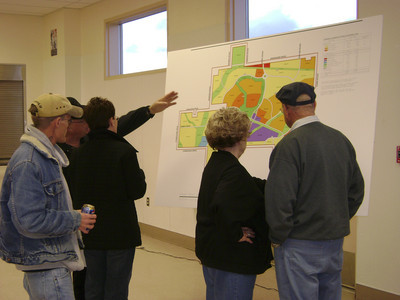Rhodes floats land plan

KINGMAN, Ariz. — It’s apparently going to take more than a sluggish economy, a mortgage loan crisis and a housing market that’s been put to sleep to keep Southern Nevada homebuilder Jim Rhodes off the radar in northwest Arizona.
Some 300 people crowded into a Kingman middle school cafeteria on Thursday for the unveiling of the master-planned community Rhodes wants to develop on 5,000 acres in nearby Golden Valley, about 110 miles south of Las Vegas.
Eight hundred people hold reservations for lots in Pravada, which could total as many as 25,000 homes at full build-out, roughly four times as many as Rhodes has built over the years in Las Vegas.
Rhodes Homes Arizona Vice President Chris Stephens expressed confidence that about 2,000 homes will be built there within five years.
The magnitude of the desert development, in a time of prolonged drought, has triggered public debate about water availability. Stephens told the crowd that the company had met its burden of proving sufficient 100-year water supply for the community.
However, several audience members were skeptical.
Project hydrologist Greg Wallace said Rhodes spent $10 million collecting data, drilling wells and testing to prove supply sufficiency and to convince the Arizona Department of Water Resources that it should approve full project development.
"There’s approximately 15 million acre-feet of groundwater in storage in Golden Valley down to 1,500 feet," Wallace said. "There will be enough water 100 years from now for that subdivision to still continue, and I’m staking my reputation on that."
There are about 326,000 gallons in an acre-foot, which is enough water to supply two average Las Vegas homes for one year.
A mix of reclamation features across the breadth of the development and conservation devices to be installed within the homes aim to save water.
Discussion of a water conservation commitment to desert landscaping, however, triggered an allegation of hypocrisy from an audience member who pointed out that the property is lined by high-rising water-guzzling palm trees.
Point well taken, Stephens noted. He could only say that the palm trees were placed along the development boundary as a "statement of arrival."
Land planner Steve McCormick’s presentation focused on sustainability and how drainage would return water to the area rather than channeling flows elsewhere.
An audience member questioned why there was no mention of use of solar energy. Stephens said solar power is under study for possible use.
Realtor Charmayne Keith said she was excited about the economic opportunities and lifestyle benefits that will result from the development. But she also chastised Rhodes Homes for bringing in outside labor to build 69 homes in Kingman two years ago, adding that the local workforce should be considered in Pravada’s construction.
Stephens said the Kingman project was Rhodes Homes’ first litmus test of the Arizona market and that familiar worker pools were used to guarantee speed and quality. He said local labor and business will be considered for Pravada, but that outside resources will also be required given the development’s size.
Two audience members who said they paid for parcel reservations said they hope construction will begin soon and asked for a development timetable.
Rhodes Homes expects to secure zoning plan approvals from local government by the spring, followed by summertime authority from the state of Arizona allowing Illinois-based Utilities Inc. to provide water and wastewater service to Pravada.
Stephens said construction of homes should begin late this year or in early 2009 after initial subdivision plans are approved by Mohave County.
"Mohave County, in our opinion, is ideally suited for this type of development," Stephens said.
Location within a triangle extending to Southern California, Las Vegas and Phoenix is an attraction along with other factors including climate and economic development opportunities, he said.
Stephens referred to a large map depicting various land uses within Pravada. They include a mix of residential densities, spaces reserved for education and fire protection facilities, commercial retail and a town center.
A golf course weaves through the development as do desert landscaped drainage areas and greenbelts that form a trail system.
"No matter where you’re living in the community, you’ll be able to either walk, jog or bike on this trail system to get to anyplace else in the community," Stephens said.
Rhodes has purchased other large parcels and plans to build four more master-planned communities in Mohave County. One of them, The Village at Whitehills, just 25 miles south of Hoover Dam, is envisioned as a future bedroom community to Henderson and Las Vegas when the commute becomes more convenient once the Hoover Dam bypass bridge is open to traffic in 2010.
Rhodes also bought another 1,000 acres for future development in Apache Junction, outside Phoenix.